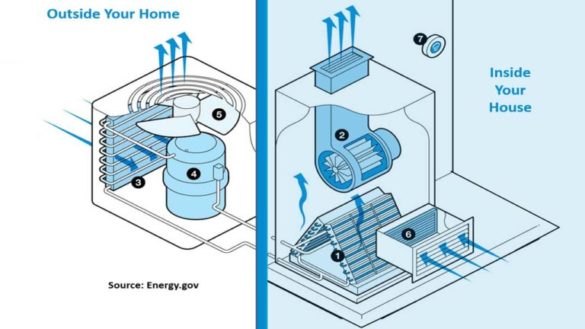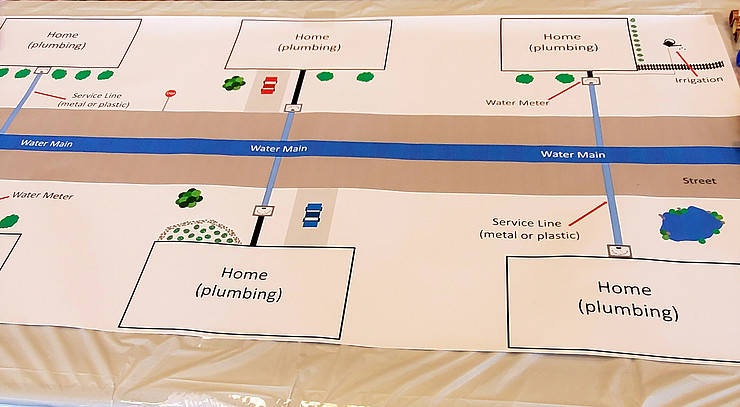The Design of Your Home's Plumbing System Explained
The Design of Your Home's Plumbing System Explained
Blog Article
They are making several good annotation related to Exploring Your Homes Plumbing Anatomy in general in the content down the page.

Comprehending exactly how your home's plumbing system functions is important for every single homeowner. From supplying tidy water for drinking, food preparation, and showering to safely getting rid of wastewater, a well-maintained plumbing system is crucial for your family's wellness and convenience. In this extensive overview, we'll check out the detailed network that makes up your home's plumbing and offer tips on maintenance, upgrades, and handling typical issues.
Introduction
Your home's pipes system is more than just a network of pipelines; it's a complex system that ensures you have accessibility to tidy water and efficient wastewater elimination. Knowing its elements and exactly how they interact can aid you avoid expensive fixings and make certain whatever runs efficiently.
Fundamental Elements of a Plumbing System
Pipes and Tubes
At the heart of your plumbing system are the pipes and tubes that carry water throughout your home. These can be made from different materials such as copper, PVC, or PEX, each with its advantages in regards to resilience and cost-effectiveness.
Components: Sinks, Toilets, Showers, and so on.
Components like sinks, toilets, showers, and tubs are where water is made use of in your house. Understanding exactly how these components attach to the pipes system aids in detecting troubles and planning upgrades.
Shutoffs and Shut-off Points
Valves manage the circulation of water in your pipes system. Shut-off shutoffs are crucial during emergencies or when you require to make repair services, permitting you to isolate parts of the system without disrupting water flow to the entire home.
Water System System
Key Water Line
The major water line connects your home to the municipal supply of water or a personal well. It's where water enters your home and is distributed to different components.
Water Meter and Stress Regulatory Authority
The water meter procedures your water use, while a stress regulatory authority makes certain that water moves at a secure stress throughout your home's pipes system, protecting against damages to pipelines and components.
Cold Water vs. Warm water Lines
Comprehending the distinction between cold water lines, which supply water directly from the main, and warm water lines, which lug warmed water from the hot water heater, assists in fixing and planning for upgrades.
Drain System
Drain Pipes Piping and Traps
Drain pipelines lug wastewater far from sinks, showers, and toilets to the sewer or septic tank. Catches stop sewer gases from entering your home and also catch particles that can trigger blockages.
Ventilation Pipes
Air flow pipes allow air into the drainage system, protecting against suction that can slow down drain and cause traps to vacant. Appropriate ventilation is important for maintaining the honesty of your pipes system.
Value of Proper Water Drainage
Making sure proper water drainage stops backups and water damage. Regularly cleansing drains pipes and maintaining catches can stop expensive repairs and expand the life of your pipes system.
Water Heating Unit
Types of Hot Water Heater
Water heaters can be tankless or traditional tank-style. Tankless heating systems warmth water on demand, while containers keep warmed water for instant use.
Just How Water Heaters Connect to the Pipes System
Comprehending just how water heaters connect to both the cold water supply and warm water distribution lines aids in identifying issues like not enough hot water or leakages.
Maintenance Tips for Water Heaters
Regularly flushing your hot water heater to eliminate sediment, inspecting the temperature setups, and inspecting for leakages can extend its life-span and improve power efficiency.
Typical Pipes Problems
Leakages and Their Causes
Leakages can occur as a result of aging pipelines, loose fittings, or high water stress. Dealing with leakages promptly avoids water damages and mold and mildew growth.
Obstructions and Blockages
Obstructions in drains and bathrooms are usually triggered by purging non-flushable items or an accumulation of oil and hair. Using drainpipe displays and being mindful of what decreases your drains pipes can avoid obstructions.
Signs of Plumbing Troubles to Watch For
Low water stress, slow drains, foul odors, or uncommonly high water costs are signs of prospective pipes troubles that should be attended to without delay.
Plumbing Maintenance Tips
Routine Examinations and Checks
Schedule annual pipes examinations to catch problems early. Try to find indicators of leaks, corrosion, or mineral build-up in taps and showerheads.
DIY Maintenance Tasks
Easy jobs like cleansing faucet aerators, checking for bathroom leakages making use of color tablets, or insulating subjected pipes in chilly environments can protect against major plumbing problems.
When to Call an Expert Plumbing Professional
Know when a plumbing issue requires expert know-how. Trying intricate repairs without proper knowledge can result in more damage and higher repair service expenses.
Updating Your Pipes System
Factors for Updating
Updating to water-efficient components or replacing old pipes can improve water quality, decrease water bills, and enhance the value of your home.
Modern Plumbing Technologies and Their Benefits
Explore modern technologies like clever leakage detectors, water-saving commodes, and energy-efficient water heaters that can save money and decrease environmental impact.
Cost Considerations and ROI
Compute the ahead of time prices versus lasting financial savings when thinking about plumbing upgrades. Many upgrades pay for themselves via lowered energy expenses and fewer repairs.
Ecological Influence and Preservation
Water-Saving Fixtures and Appliances
Mounting low-flow taps, showerheads, and bathrooms can considerably reduce water use without compromising performance.
Tips for Reducing Water Usage
Straightforward routines like taking care of leaks promptly, taking much shorter showers, and running complete loads of laundry and recipes can save water and lower your energy costs.
Eco-Friendly Plumbing Options
Consider lasting pipes materials like bamboo for floor covering, which is durable and green, or recycled glass for counter tops.
Emergency Readiness
Actions to Take During a Pipes Emergency situation
Know where your shut-off valves are located and just how to turn off the supply of water in case of a burst pipe or major leakage.
Significance of Having Emergency Calls Useful
Keep get in touch with information for local plumbers or emergency solutions easily offered for quick reaction throughout a plumbing dilemma.
Do It Yourself Emergency Fixes (When Suitable).
Short-term repairs like making use of air duct tape to patch a leaking pipeline or positioning a bucket under a leaking tap can lessen damage up until an expert plumbing professional arrives.
Final thought.
Understanding the composition of your home's plumbing system equips you to keep it efficiently, conserving time and money on repair services. By following routine maintenance routines and remaining informed regarding modern-day plumbing modern technologies, you can guarantee your plumbing system operates successfully for years to find.
HOW YOUR PLUMBING SYSTEM WORKS
Which Pipes Do What?
Blue lines = fresh water supply entering the building
Red lines = hot water supply entering the building
Grey lines = pipes carrying waste away from the building and venting pipes carrying gases away from the building (through the roof)
YOUR MAIN PLUMBING SYSTEMS
There are two main plumbing systems that support your home s basic plumbing needs one that brings clean water into your home, and one that sends dirty water away from your home. Connected to the toilet, bath, shower, and other faucets in your home, these two systems keep your water flowing in the right directions.
ACCESSING FRESH WATER
Fresh and clean water is brought into your home through the main water supply line . Filtered through one pipe, this water is pressured to flow into the various fixtures in your home at any given time.
This water can be sourced from a well located on your property, a pond or river (mostly cottages), or, as in most cases, from the city s municipal water treatment centre. However, it is important to note that water that is untreated, such as the water siphoned from ponds or rivers, may not be safe to drink. Personal water supplies always need to be treated for hardness and contaminants before consumed.
MUNICIPAL WATER SUPPLIES
Improve taste and odour
Remove sediment
Eliminate hardness
Reduce chlorine
COLD WATER SUPPLY VS. HOT WATER SUPPLY
Cold water flows into your home or building through the service line, which then distributes hot or cold water to your fixtures. This line is most commonly run through a central column that runs floor to floor. Hot water runs in short and straight pipes as the longer the pipeline, the more heat that will be lost in the transfer. Having shorter pipes also allows residents to access hot water more quickly.
WASTE WATER SYSTEM
Your wastewater system is divided into two parts pipes that send wastewater away from your home and venting pipes that send sewer gas away from your home. Sewage water travels through pipes that flush the water and waste towards local sewers that are operated and managed by your city or town. Most sewer systems rely on gravity to move the wastewater to where it needs to go.
The further away from your toilet or sink, the larger wastewater pipes become. This allows for waste to be disposed of from various parts of your home or business at once without pipe blockages. The angle and flow of these pipes are also essential for keeping your waste pipes clear of build up.
https://harrisplumbing.ca/how-your-home-plumbing-system-works/

HOW YOUR PLUMBING SYSTEM WORKS
Which Pipes Do What?
YOUR MAIN PLUMBING SYSTEMS
There are two main plumbing systems that support your home s basic plumbing needs one that brings clean water into your home, and one that sends dirty water away from your home. Connected to the toilet, bath, shower, and other faucets in your home, these two systems keep your water flowing in the right directions.
ACCESSING FRESH WATER
Fresh and clean water is brought into your home through the main water supply line . Filtered through one pipe, this water is pressured to flow into the various fixtures in your home at any given time.
This water can be sourced from a well located on your property, a pond or river (mostly cottages), or, as in most cases, from the city s municipal water treatment centre. However, it is important to note that water that is untreated, such as the water siphoned from ponds or rivers, may not be safe to drink. Personal water supplies always need to be treated for hardness and contaminants before consumed.
MUNICIPAL WATER SUPPLIES
COLD WATER SUPPLY VS. HOT WATER SUPPLY
Cold water flows into your home or building through the service line, which then distributes hot or cold water to your fixtures. This line is most commonly run through a central column that runs floor to floor. Hot water runs in short and straight pipes as the longer the pipeline, the more heat that will be lost in the transfer. Having shorter pipes also allows residents to access hot water more quickly.
WASTE WATER SYSTEM
Your wastewater system is divided into two parts pipes that send wastewater away from your home and venting pipes that send sewer gas away from your home. Sewage water travels through pipes that flush the water and waste towards local sewers that are operated and managed by your city or town. Most sewer systems rely on gravity to move the wastewater to where it needs to go.
The further away from your toilet or sink, the larger wastewater pipes become. This allows for waste to be disposed of from various parts of your home or business at once without pipe blockages. The angle and flow of these pipes are also essential for keeping your waste pipes clear of build up.
https://harrisplumbing.ca/how-your-home-plumbing-system-works/
I discovered that entry on Anatomy of a House: Understanding the Components when browsing on the internet. Are you aware of somebody who is excited by the topic? Take a moment to promote it. Thank you for taking the time to read it.
Book An Appointment Report this page